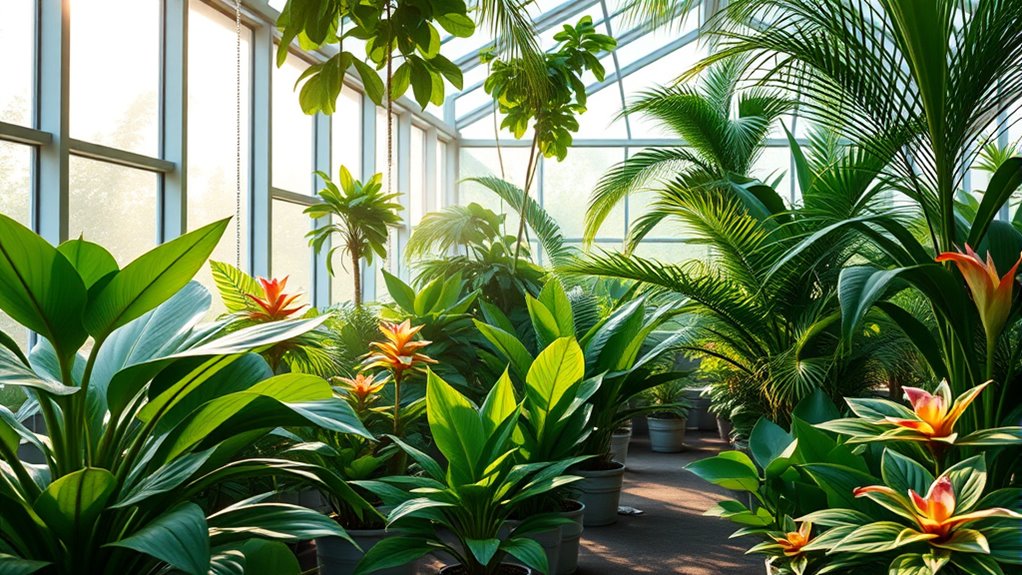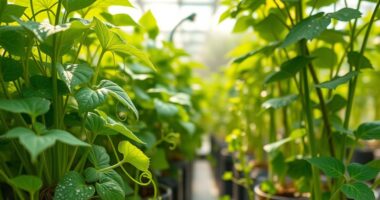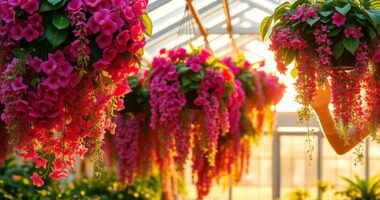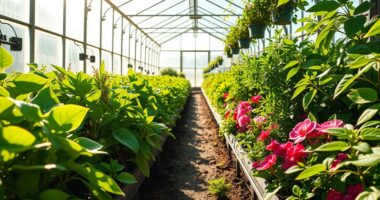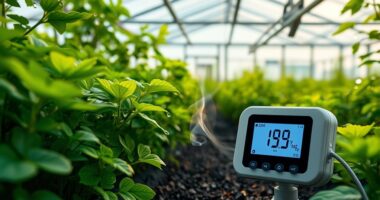To care for tropical plants in a greenhouse, you need to regulate humidity between 60-80%, maintain temperatures of 75-85°F during the day, and guarantee proper lighting with adjustable shading. Water your plants consistently but avoid waterlogging, and use well-draining soil enriched with organic matter. Regularly monitor pests, prune dead foliage, and promote good airflow. Keep these practices in mind, and you’ll discover more ways to create the ideal environment for your tropical plants.
Key Takeaways
- Maintain humidity levels between 60-80% using misting, humidity trays, and good airflow to prevent stress and support lush growth.
- Regulate temperature between 75-85°F during the day and cooler at night to avoid stress and optimize nutrient absorption.
- Provide appropriate lighting with natural sunlight and supplemental artificial light tailored to each plant’s needs.
- Use well-draining, organic-rich soil with pH adjustments to ensure proper nutrient uptake and healthy root development.
- Regularly monitor for pests and diseases, prune damaged foliage, and ensure proper watering and fertilization practices.
Maintaining Optimal Humidity Levels
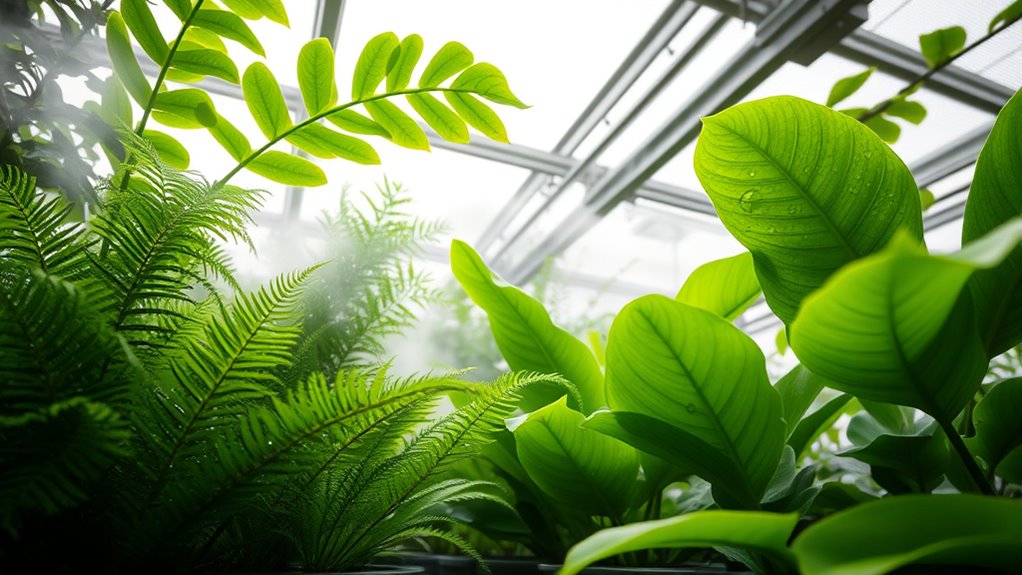
Maintaining the right humidity levels is essential for healthy tropical plants in your greenhouse. Proper humidity control guarantees plants retain moisture, preventing stress and promoting lush growth.
Proper humidity ensures tropical plants stay healthy and lush in your greenhouse.
You should regularly monitor humidity levels with a hygrometer, aiming for 60-80%. To boost humidity, misting techniques are highly effective; lightly spray your plants with water multiple times a day, especially during dry periods. Use a spray bottle or automated misting system for consistent coverage.
Avoid over-misting, which can lead to mold or fungal issues. Instead, focus on maintaining steady humidity by combining misting with other methods like humidity trays or ensuring good airflow.
Consistent humidity control creates an ideal environment, helping your tropical plants flourish and stay healthy in your greenhouse.
Regulating Temperature for Tropical Thrive

To guarantee your tropical plants thrive, regulating the greenhouse temperature is essential, as these plants are sensitive to fluctuations. Consistent warmth supports healthy growth, tropical plant nutrition, and soil health management. Use heaters or fans to maintain temperatures between 75-85°F during the day and slightly cooler at night. Avoid sudden temperature shifts that can stress plants or hinder nutrient absorption. Proper temperature regulation is crucial for preventing stress and promoting optimal growth. Maintaining the correct ambient conditions helps ensure your tropical plants remain healthy and vigorous. Here’s a quick guide: Temperature Control Methods include various techniques to optimize conditions for tropical plants, including monitoring humidity levels to prevent dehydration and disease. Additionally, using air purifiers with HEPA filters can improve indoor air quality by reducing airborne pollutants that might stress your plants.
Providing Adequate Lighting Conditions
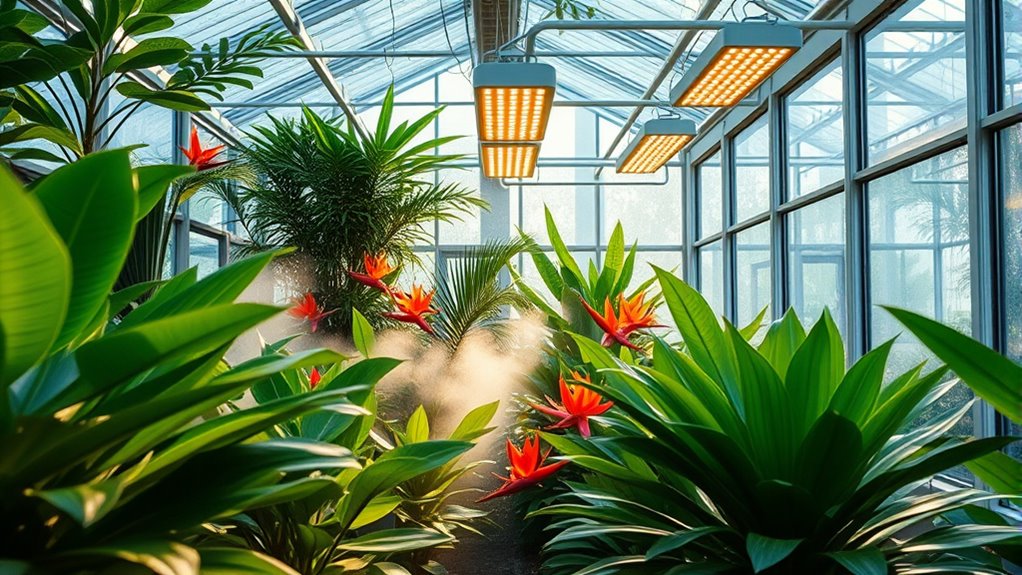
To keep your tropical plants healthy, you need to provide the right amount of light. Consider their ideal light intensity and how long they need it each day to thrive. If natural light isn’t enough, explore artificial lighting options to meet their needs effectively. Incorporating natural lighting and smart lighting controls can also boost your overall plant care routine, ensuring your tropical plants remain vibrant and healthy. Additionally, understanding the best anime movies can provide relaxing entertainment during your plant care routine. Paying attention to plant-specific lighting requirements helps prevent issues like etiolation and promotes lush growth.
Optimal Light Intensity
Providing the right amount of light is essential for healthy tropical plants in a greenhouse. Too much light can cause leaf scorch, while too little hampers growth. Achieving ideal light intensity involves shade management to control light spectrum and prevent overstimulation. Use shading materials or adjustable screens to fine-tune exposure, especially during peak sunlight hours. Aim for 2000-3000 foot-candles, depending on the plant species. Consider the light spectrum, as red and blue wavelengths are crucial for photosynthesis. Here’s a quick guide:
| Light Intensity | Shade Management | Light Spectrum |
|---|---|---|
| Too low | No shade | Insufficient blue |
| Ideal | Partial shade | Balanced spectrum |
| Too high | Full shade | Excess red |
| Varied levels | Adjust as needed | Tailored to plant |
Maintaining proper light spectrum is vital for ensuring optimal plant development and vibrant foliage. Adjust these factors for healthy, vibrant tropical plants.
Light Duration Needs
Ensuring your tropical plants receive the right amount of light each day is crucial for their healthy growth. You need to consider their shade requirements, as some species thrive in lower light, while others need more direct exposure.
Seasonal light variations also play a significant role; during winter, daylight hours are shorter, so you may need to extend light duration to compensate. In summer, longer daylight allows for reduced artificial lighting or shorter periods of supplemental light.
Maintaining consistent light duration helps prevent stress and encourages ideal development. Pay close attention to your plants’ responses, adjusting light periods accordingly.
Properly managing light duration ensures your tropical plants stay healthy, vibrant, and well-adjusted to their greenhouse environment.
Artificial Lighting Options
When natural light falls short, choosing the right artificial lighting options becomes essential for your tropical plants’ health. You can consider LED options, which are energy-efficient and produce minimal heat, making them ideal for controlled greenhouse environments. LED grow lights can be tailored to emit specific wavelengths that promote healthy growth and flowering. Additionally, understanding the light spectrum required by your plants can help you select the most effective lighting setup. Proper placement and timing of artificial lighting can compensate for reduced natural light, helping your plants thrive even during darker months. Incorporating photosynthetically active radiation considerations into your lighting choices ensures your plants receive the most beneficial wavelengths for optimal growth. Understanding light intensity requirements can further enhance your plant care routine and prevent issues like etiolation or stress. Monitoring light duration is also crucial to simulate natural day-night cycles and support healthy development.
Ensuring Proper Watering Techniques
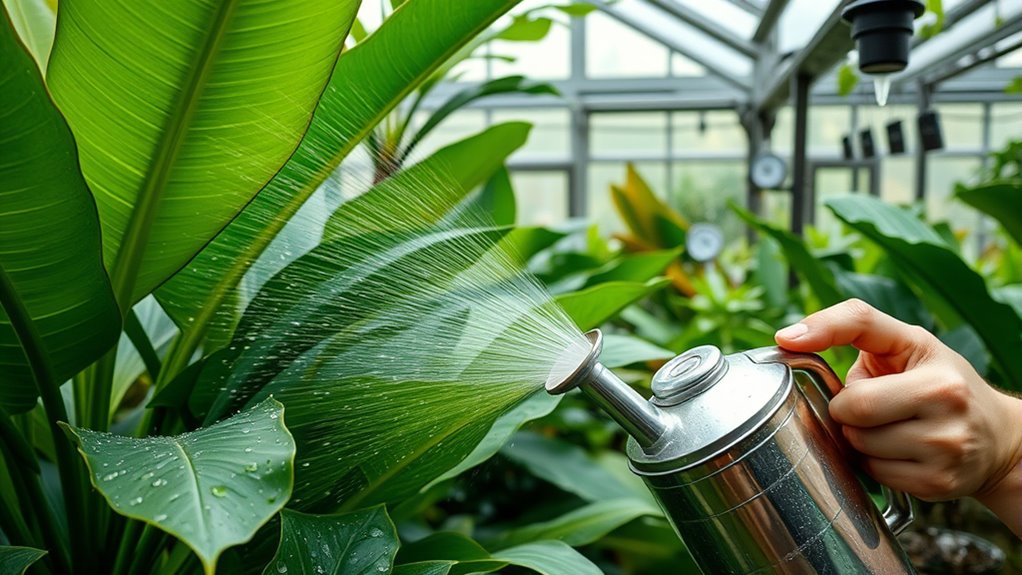
To keep your tropical plants thriving in a greenhouse, mastering proper watering techniques is essential. You need to adjust your watering frequency based on the plant’s needs and environmental conditions, avoiding both overwatering and underwatering. Proper moisture retention is key; guarantee the soil stays consistently moist but not waterlogged. Regularly monitoring soil moisture with your fingers or a moisture meter ensures accurate watering. You should also consider using well-draining soil to prevent water buildup and promote oxygen flow. Additionally, using smart moisture sensors can help you maintain optimal soil conditions and prevent root rot. Incorporating automation technologies such as moisture sensors can further optimize watering schedules and reduce manual effort. Being aware of the regional climate can also guide you in customizing your watering schedule to suit your specific environment.
Choosing the Right Soil and Fertilization
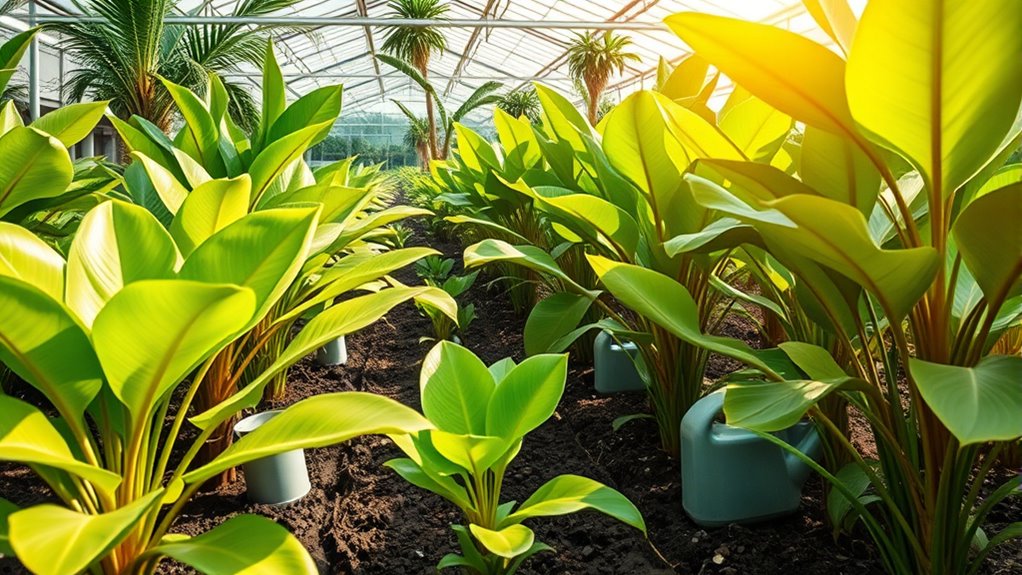
Choosing the right soil and fertilization is key to healthy tropical plants in your greenhouse. You need to focus on soil composition, selecting fertilizers, and maintaining proper pH levels for ideal growth. Ensuring your soil has the correct nutrient balance will give your plants the nutrients they need to thrive.
Soil Composition Essentials
Selecting the right soil is crucial for the health of your greenhouse tropical plants, as it directly affects their growth, nutrient uptake, and overall vitality. You should focus on creating a well-balanced mix that promotes aeration, moisture retention, and nutrient availability.
Incorporate soil amendments like organic matter to improve texture and fertility, ensuring ideal conditions for root development. Pay close attention to compost quality, choosing high-quality, well-decomposed compost that provides essential nutrients without introducing pathogens.
A good soil mix also involves balancing pH levels to suit tropical plants’ needs. Consider blending different components, such as peat, perlite, and organic compost, to achieve the perfect environment.
Proper soil composition fosters healthy growth, reduces disease risk, and encourages vibrant, thriving plants in your greenhouse.
Fertilizer Types and Timing
Using the right fertilizers at appropriate times is essential for maintaining vibrant and healthy tropical plants in your greenhouse. Organic options, like compost teas and fish emulsion, offer natural nutrients that promote strong growth.
When choosing between liquid vs granular fertilizers, consider your plants’ needs and application preferences. Liquid fertilizers are quick-absorbing, ideal for rapid nutrient delivery, and can be easily applied during regular watering.
Granular fertilizers release nutrients slowly, providing steady nourishment over time and reducing the risk of overfeeding.
Timing is key: fertilize more frequently during active growth periods and cut back during dormancy.
Always observe your plants for signs of nutrient deficiencies, and adjust your fertilization schedule accordingly to keep your tropical plants thriving.
Ph Balance Optimization
To fine-tune pH balance for your tropical plants, it’s essential to start with the right soil and adjust fertilization practices accordingly. Begin with accurate pH measurement to determine your soil’s current level.
If pH is too low or high, pH adjustment becomes necessary to create ideal conditions for nutrient absorption. Selecting soils with proper pH ranges ensures healthy growth, while tailored fertilization helps maintain stability.
Consider these key points:
- Use pH testing kits regularly to monitor soil conditions.
- Incorporate amendments like lime or sulfur for precise pH adjustment.
- Choose fertilizers formulated for specific pH levels to prevent imbalances.
Maintaining proper pH enhances nutrient availability, promoting lush, vibrant tropical plants in your greenhouse.
Managing Pest and Disease Risks
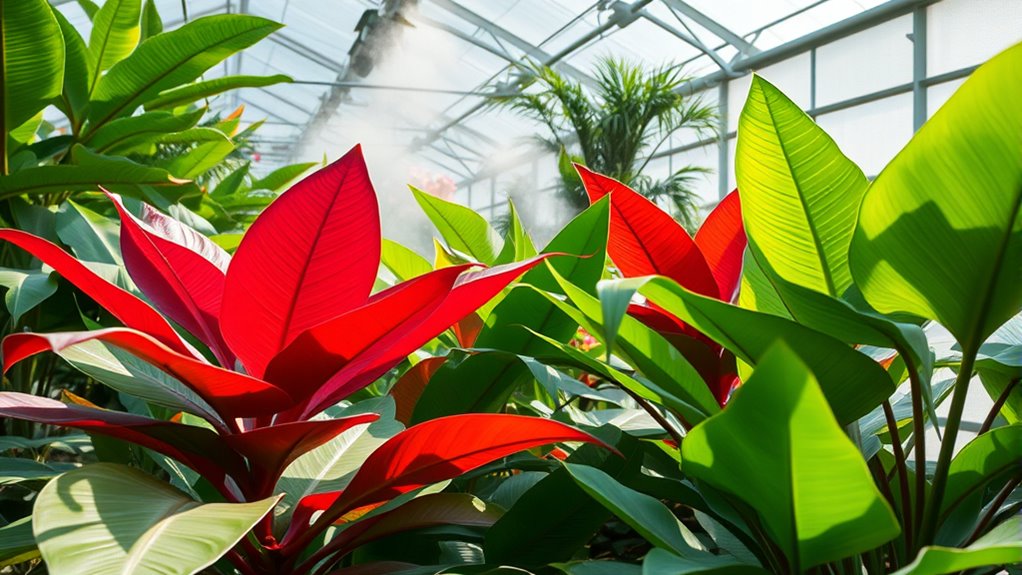
Managing pest and disease risks is essential to keeping your greenhouse tropical plants healthy and thriving. Regular pest monitoring helps catch problems early, preventing infestations from spreading. Disease prevention starts with proper sanitation and ensuring good air circulation. Stay vigilant for signs of trouble, like discolored leaves or unusual spots. Use the table below to visualize the emotional impact of neglect versus proactive care:
| Neglect | Careful Management |
|---|---|
| Stress and decline | Healthy, vibrant growth |
| Frustration and loss | Confidence in healthy plants |
| Rapid spread of pests/diseases | Peace of mind |
| Increased costs | Cost-effective maintenance |
| Disappointment | Satisfaction in thriving plants |
Pruning and Propagation Practices

Pruning and propagation are essential practices for maintaining healthy tropical plants in your greenhouse. Proper pruning encourages vigorous growth, enhances flower arrangement, and prevents disease.
When pruning, focus on removing dead or damaged leaves, which improves airflow and reduces pest risks.
Root trimming is crucial during propagation; it stimulates new root growth and ensures the plant establishes strongly. To propagate, take cuttings from healthy stems and trim roots carefully to promote quick recovery.
For advanced techniques, consider layering or division, especially for larger plants.
Regular pruning keeps plants manageable and encourages flowering.
Remember, clean tools prevent disease spread, and timing is key—prune during active growth for best results.
These practices help you maintain robust, vibrant tropical plants year-round.
Creating a Suitable Ventilation System
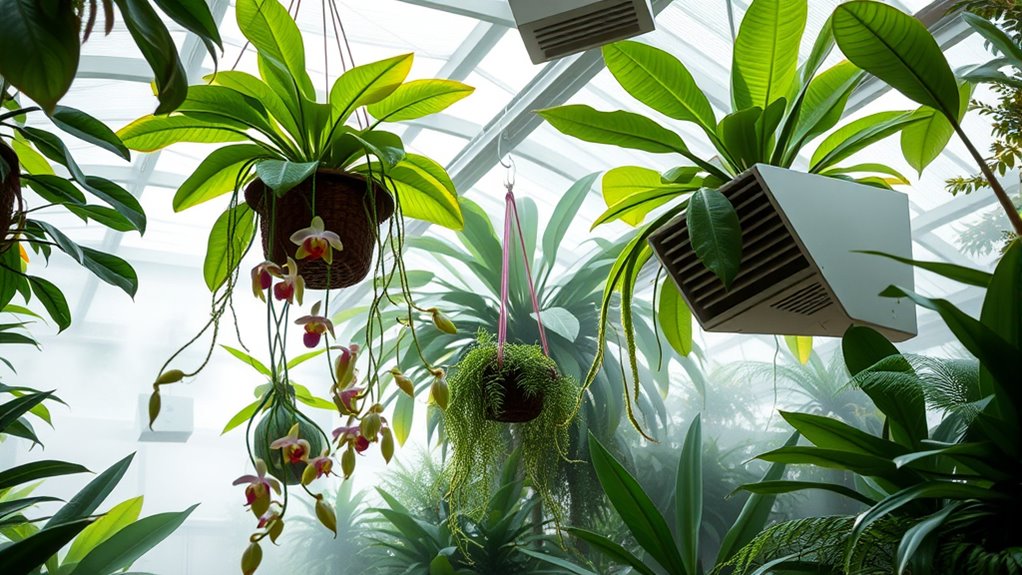
Creating a suitable ventilation system is essential for maintaining ideal growing conditions in your greenhouse. Good air circulation helps regulate temperature and humidity, preventing issues like mold and fungal infections that tropical plants are prone to. It also ensures fresh CO₂ reaches your plants, supporting healthy growth.
Proper ventilation reduces odors by dispersing stale or excess humidity, keeping the air clean and pleasant. You can achieve this by installing exhaust fans, intake vents, or adjustable louvers that work together to promote continuous airflow.
Position vents strategically to maximize airflow across all plant areas. Regularly inspect and maintain your system to prevent blockages or mechanical failures.
With effective air circulation and odor control, your tropical plants will thrive in a healthy, well-ventilated environment.
Frequently Asked Questions
How Can I Prevent Fungal Infections in Tropical Greenhouse Plants?
To prevent fungal infections in your greenhouse plants, focus on fungal prevention strategies like maintaining proper airflow and avoiding overwatering.
Guarantee greenhouse sanitation by regularly cleaning surfaces and tools to eliminate spores. Keep humidity levels in check and remove any diseased or dead plant material promptly.
These steps help create an environment less hospitable for fungi, protecting your tropical plants and promoting healthy growth.
What Are the Signs of Nutrient Deficiencies in Tropical Plants?
Did you know that over 50% of tropical plant issues stem from nutrient deficiencies? You’ll notice symptoms like yellowing leaves, stunted growth, or leaf spots, which indicate nutrient deficiency symptoms.
To prevent these, follow a consistent fertilizer application schedule tailored to your plants’ needs. Regular monitoring helps catch deficiencies early, ensuring your tropical plants stay healthy and thrive.
Adjust your fertilization routine accordingly for peak growth.
How Often Should I Change or Replenish Greenhouse Soil?
You should change or replenish greenhouse soil every 1 to 2 years, depending on plant health and soil tests. Regular soil testing helps determine nutrient levels and when amendments are needed.
When replenishing, consider container selection to guarantee proper drainage and avoid soil compaction. Fresh soil provides essential nutrients, promotes healthy growth, and prevents disease buildup.
This process ensures your tropical plants thrive in the greenhouse environment.
What Are Eco-Friendly Methods for Pest Control in Tropical Greenhouses?
Did you know that using eco-friendly pest control methods can reduce chemical runoff by up to 90%?
In your tropical greenhouse, consider biodegradable pesticides that break down naturally, minimizing harm to your plants and the environment.
Additionally, companion planting attracts beneficial insects and repels pests, creating a natural barrier. These methods not only protect your plants but also promote a sustainable, healthy greenhouse ecosystem.
How Can I Monitor and Adjust Humidity and Temperature Simultaneously?
To monitor and adjust humidity control and temperature regulation simultaneously, you should use a digital climate control system with sensors that track both factors in real-time.
Regularly check the readings and adjust the thermostat or humidifiers/dehumidifiers accordingly.
You can also set alerts for rapid changes, ensuring you respond quickly to maintain ideal conditions.
This approach helps keep your tropical plants healthy and thriving.
Conclusion
By mastering these tropical plant care secrets, you’ll turn your greenhouse into a lush, jungle paradise where every leaf gleams like emeralds and each flower bursts with color. With just a little effort, you’ll create a haven so perfect, even the most finicky plants will sing your praises! Get ready to impress everyone with your green thumb—your plants will thank you by thriving like they’re on a tropical vacation every single day!
